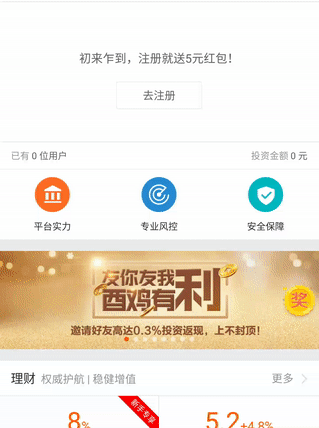可能是最in的React Native使用原生自定义下拉刷新组件
作者: imilk
版权声明:本文图文为博主原创,转载请注明出处。
在 2016 年移动端跨平台开发是几个最热的技术之一,相信在 2017 年这股热潮将持续发酵。为什么这么说呢,因为随着业务的爆发式增长,传统的原生开发模式有点显得跟不上节奏了,这也促使各个公司希望寻找到一个更加高效的开发方案,当下可以被选择的方案中, React Native 及 Weex 都是不错的技术方案。在年前团队内部的一场 React Native vs Weex 的技术对垒中本来我选择的是 Weex 的阵营,但当时在多维的技术指标中新生的 Weex 还是不敌 React Native ,团队内部最终敲定了采用 React Native 跨平台方案。
1、概述
闲话不多说,这里的主要目的是跟大家聊聊 React Native 在 Android 平台使用原生自定义 View ,这里默认大家对 React Native 已经有一定的了解, React Native 中的组件都是基于 iOS/Android 的官方组件进行封装,所以在一些特别的场景下并不能很好的满足需求。正如标题中的下拉刷新组件, React Native 在 Android 平台采用的是 android.support.v4.widget.SwipeRefreshLayout ,一些 iOS 设计优先的团队(譬如我司)而言对于 Android 开发人员简直就是灾难。在众多开源的 React Native 项目中大家也不会再这些细节上较真,但是公司的 UED 这关可不好过。
听说流行有图有真相,那先来个在 iOS 端经典的菊花图的 Android reac-native 版:

2、Android 端的支持实现
适配 Android 平台的原生组件可以参看官方文档 Native UI Components ,如果网络不方便的话也可以参看翻译版 原生UI组件 。
2.1 自定义下拉刷新控件
这里就不讲如何自定义 Android 控件,假设你是一位有一定经验的开发人员。
//自定义的下拉刷新控件
public class PullToRefreshView extends ViewGroup {
...
public PullToRefreshView(Context context) {
...
}
public void setRefreshing(boolean refreshing) {
...
}
public void setOnRefreshListener(OnRefreshListener listener) {
...
}
}
2.2 创建 ViewManager 的实现类
官方文档中给我们的示例是创建 SimpleViewManager 的实现类,但此处的下拉刷新控件是个 ViewGroup ,所以此处实现类应继承 ViewManager 的另一个子类 ViewGroupManager 。
public class SwipeRefreshViewManager extends ViewGroupManager<PullToRefreshView>{
@Override
public String getName() {
return "PtrLayout";
}
@Override
protected PullToRefreshView createViewInstance(ThemedReactContext reactContext) {
return new PullToRefreshView(reactContext);
}
...
}
到这里一个简单的 ViewGroupManager 就实现了。
2.3 给 ViewManager 添加事件监听
但我们这是一个下拉刷新控件,有一个问题是我们如何将下拉刷新的监听事件传递给 JavaScript 呢?官方文档中写的并不清晰,还是翻阅源码吧,果不其然在源码中寻找到了我们想要的答案。
覆写 addEventEmitters 函数将事件监听传递给 JavaScript 。
public class SwipeRefreshViewManager extends ViewGroupManager<PullToRefreshView>{
...
@Override
protected void addEventEmitters(ThemedReactContext reactContext, PullToRefreshView view) {
view.setOnRefreshListener(new PullToRefreshView.OnRefreshListener() {
@Override
public void onRefresh() {
reactContext.getNativeModule(UIManagerModule.class).getEventDispatcher()
.dispatchEvent(new PtrRefreshEvent(view.getId()));
}
});
}
@Nullable
@Override
public Map<String, Object> getExportedCustomDirectEventTypeConstants() {
return MapBuilder.<String, Object>builder()
.put("topRefresh", MapBuilder.of("registrationName", "onRefresh"))
.build();
}
...
}
我们将事件封装为 PtrRefreshEvent 。
public class PtrRefreshEvent extends Event<PtrRefreshEvent>{
protected PtrRefreshEvent(int viewTag) {
super(viewTag);
}
@Override
public String getEventName() {
return "topRefresh";
}
@Override
public void dispatch(RCTEventEmitter rctEventEmitter) {
rctEventEmitter.receiveEvent(getViewTag(),getEventName(),null);
}
}
细心地你肯定发现了 getExportedCustomDirectEventTypeConstants 这个函数,这里先说明一下,覆写该函数,将 topRefresh 这个事件名在 JavaScript 端映射到 onRefresh 回调属性上,这部分我们后面会在结合 JavaScript 再解释下用法。
关于组件这部分大家可以参看 React Native 的 Android 部分的代码。
2.4 使用@ReactProp 注解导出属性的设置方法
这部分内容官方文档的介绍足够使用了,这里不再细说。
public class SwipeRefreshViewManager extends ViewGroupManager<PullToRefreshView>{
...
@ReactProp(name = "refreshing")
public void setRefreshing(PullToRefreshView view, boolean refreshing) {
view.setRefreshing(refreshing);
}
}
2.5 将 ViewManager 注册到应用
如果你熟悉 Android 的 React Native 集成的话,你只需要将 SwipeRefreshViewManager 添加到 ReactPackage 中即可,
public class MainPackage implements ReactPackage {
...
@Override
public List<ViewManager> createViewManagers(ReactApplicationContext reactApplicationContext) {
return Arrays.asList(new SwipeRefreshViewManager());
}
...
}
到这里 Android 端的实现已经全部完成了。
3、React/JS 端的组件实现及使用
接下来我们来聊一聊使用 React 实现下拉刷新的组件,当然在这之前期望你对 jsx/es6 的语法及 react/react-native 的 API 有一定的了解。
3.1 实现下拉刷新组件
还记得吗,在 Android 我们通过 SwipeRefreshViewManager 中 getName 返回的控件名称,将会在这里用于引用这个原生控件。
'use strict';
import React, {Component, PropTypes} from 'react';
import {View, requireNativeComponent} from 'react-native';
import NativeMethodsMixin from 'react/lib/NativeMethodsMixin';
import mixin from 'react-mixin';
//引用原生下拉刷新控件
const NativePtrView = requireNativeComponent('PtrLayout', PtrView);
//封装一个react组件,该组件中引用了原生控件的实现
class PtrView extends Component {
static propTypes = {
...View.propTypes,
onRefresh: PropTypes.func,
refreshing: PropTypes.bool.isRequired
};
_nativeRef = (null: ?PtrView);
_lastNativeRefreshing = false;
constructor(props) {
super(props);
}
componentDidMount() {
this._lastNativeRefreshing = this.props.refreshing;
}
componentDidUpdate(prevProps = {refreshing: false}) {
if (this.props.refreshing !== prevProps.refreshing) {
this._lastNativeRefreshing = this.props.refreshing;
} else if (this.props.refreshing !== this._lastNativeRefreshing) {
this._nativeRef.setNativeProps({refreshing: this.props.refreshing});
this._lastNativeRefreshing = this.props.refreshing;
}
}
//渲染原生下拉刷新控件,这里onRefresh就是在ViewManager::getExportedCustomDirectEventTypeConstants
//这个函数中 topRefresh 的映射属性。
render() {
return (
<NativePtrView
{...this.props}
ref={ref => this._nativeRef = ref}
onRefresh={this._onRefresh.bind(this)}/>
)
}
_onRefresh() {
this._lastNativeRefreshing = true;
this.props.onRefresh && this.props.onRefresh();
this.forceUpdate();
}
}
mixin.onClass(PtrView, NativeMethodsMixin);
export {PtrView};
3.2 下拉刷新组件的使用
说到使用就太简单了,虽然简单但仍然要说,我们知道官方提供的组件例如 ListView 中通过 refreshControl 来指定刷新控制器,用法是这样的:
class Demo1 extends Component {
...
render() {
return (
<View style={{flex: 1}}>
<ListView
...
refreshControl={
<RefreshControl
refreshing={this.state.refreshing}
onRefresh={this._refresh.bind(this)} />
}
/>
</View>
)
}
}
我就在想既然可以通过 refreshControl 来指定刷新控制器,那我自定义的下拉刷新组件是不是也可以通过 refreshControl 来指定呢?带着这样的疑问,我仔细读了读 ListView/ScrollView 的源码,发现这个猜想还是蛮靠谱的,也赞叹 Facebook 的工程师们的妙笔生花。
const ScrollView = React.createClass({
let ScrollViewClass;
if (Platform.OS === 'ios') {
ScrollViewClass = RCTScrollView;
} else if (Platform.OS === 'android') {
if (this.props.horizontal) {
ScrollViewClass = AndroidHorizontalScrollView;
} else {
ScrollViewClass = AndroidScrollView;
}
}
...
const refreshControl = this.props.refreshControl;
if (refreshControl) {
if (Platform.OS === 'ios') {
...
} else if (Platform.OS === 'android') {
// On Android wrap the ScrollView with a AndroidSwipeRefreshLayout.
// Since the ScrollView is wrapped add the style props to the
// AndroidSwipeRefreshLayout and use flex: 1 for the ScrollView.
// 此处就是重点,通过 cloneElement 创建一个新的 ReactElement,而 refreshControl 是通过 props 指定而来并没有写死,Good!
return React.cloneElement(
refreshControl,
{style: props.style},
<ScrollViewClass {...props} ref={this._setScrollViewRef}>
{contentContainer}
</ScrollViewClass>
);
}
}
return (
...
);
})
基于以上的分析以及我们对于属性的封装,我们的写法也相当的原味:
class Demo2 extends Component {
...
render() {
return (
<View style={{flex: 1}}>
<ListView
...
refreshControl={
//这里为了保证只在Android平台上使用该组件,如果iOS端也有原生控件的实现,
//那就不必考虑平台了。
Platform.OS === 'android' ?
<PtrView
refreshing={this.state.refreshing}
onRefresh={this._refresh.bind(this)} />
:
<RefreshControl
refreshing={this.state.refreshing}
onRefresh={this._refresh.bind(this)} />
}
/>
</View>
)
}
}
希望你能有所收获,本文完!
最后祝大家鸡年大吉吧!











![[HBLOG]公众号](https://www.liuhaihua.cn/img/qrcode_gzh.jpg)

